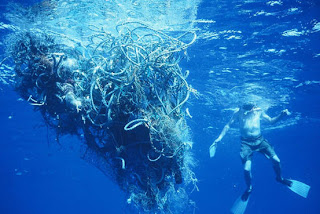As you know from my previous post, the gyre is actually so big that it has split into two separate patches. According to Howstuffworks.com, the patches are connected by the Subtropical Convergence Zone, a 6,000-mile long current. Considering that this only connects the two gyres, millions of pound of trash collect in the current as well.
Let’s dig a little deeper and take a look into what the patches really consist of. As I have mentioned earlier, the patch mainly consists of plastic. A study done in 2006 by The United Nations Environment Program reported that every square mile of ocean contains 46,000 pieces of plastic. The world produces over 200 billion pounds of plastic a year, and about 10 percent of it ends up in the ocean. Also according to Howstuffworks.com, seventy percent of this plastic sinks, while the rest of it floats or washes up on shore.
According to wikipedia.org, when plastics reach the ocean, they often break down into smaller pieces, while still remaining a polymer, or a large molecule composed of repeating structural units, connected by covalent chemical bonds. This process continues until the previous solid plastic, and eventually releases toxic chemicals into the ocean such as bisphenol A, PCBs and polystyrene.
With all this said, CLICK HERE to watch yet another wonderful video.



No comments:
Post a Comment